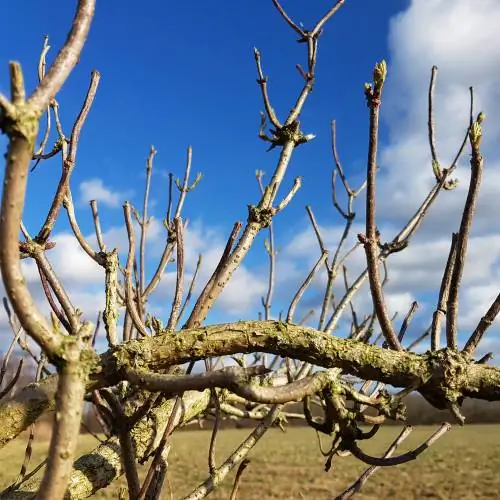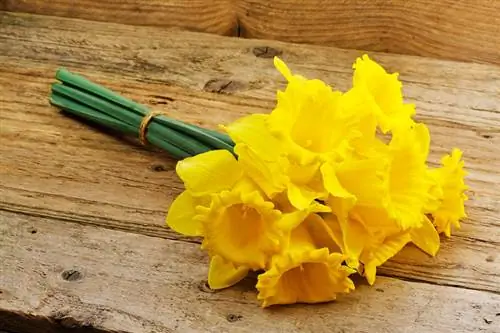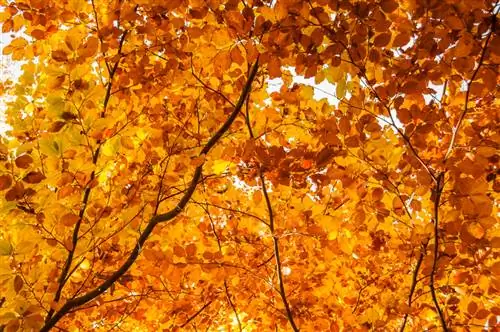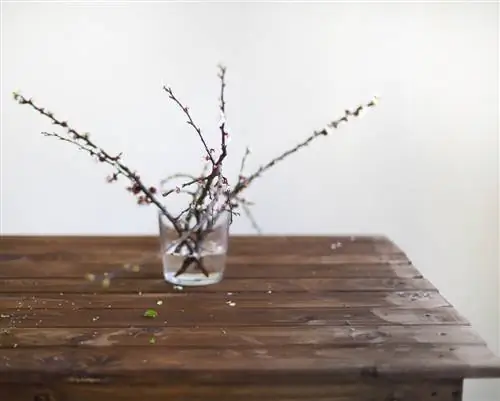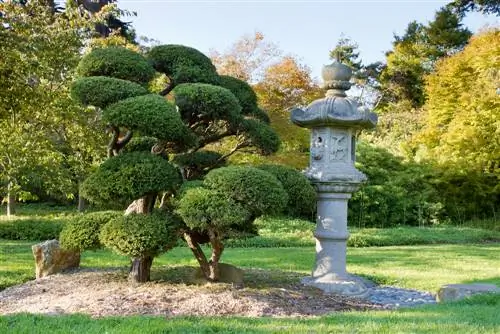- Author admin [email protected].
- Public 2023-12-26 14:17.
- Last modified 2025-01-23 11:21.
Black currants have to be cut differently than their red counterparts or other berry bushes. This tutorial explains in detail and comprehensibly when and how to properly blend Ribes nigrum. Read the instructions for all important cutting types here.
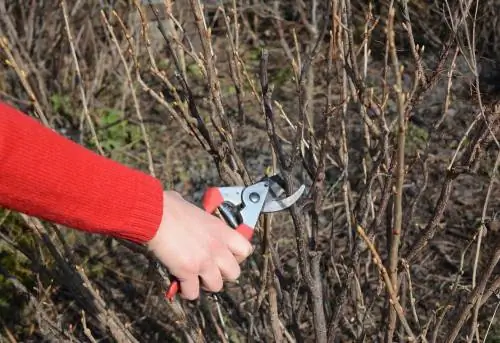
When and how should you cut blackcurrants?
Blackcurrants should be pruned in spring (February or March) or after harvest to promote productive growth. Important types of pruning include planting, training, maintenance and rejuvenation pruning. Older, dark brown shoots should be removed and young, light brown shoots should be preferred.
Fruitwood makes the difference
Blackcurrants occupy a special position among currants when it comes to pruning care. The juiciest berries grow onannual long shootsAmong the diverse types of shoots, you can identify the valuable fruit wood by a length of more than20 centimetersFurthermore, it is marked by alight brown color the youthful age. Over the years, the bark color changes to dark brown and indicates exhausted wood.
Cutting types and dates
If you plant and train your blackcurrants, you will have a lot of fun with the berry bushes with their hosts of juicy, black vitamin C bombs. An annual maintenance cut ensures a fresh supply of annual fruit canes. Rejuvenation pruning gives an old currant new courage to live. The following table summarizes useful types of cuts and dates:
| Cut style | Goal/Occasion | best date | alternative date |
|---|---|---|---|
| Planting and training pruning | richly branched framework structure | 1. until the 3rd year in February or March | none |
| Conservation cut | high-yield growth, promote fruit wood | from the 4th year in February or March | after harvest |
| Rejuvenation cut | revitalize old berry bush | Late winter to early March | none |
| Topiary tree trunk | well-formed crown with maximum yield power | early spring | after harvest |
Planting and training pruning
On the autumn planting day, light pruning focuses on damaged shoot tips and root strands. It is not advisable to carry out extensive pruning on a young blackcurrant so shortly before winter because there is a risk of frost damage. Only in the following spring do you cut back all shoots by a third or half. A strong branching then begins. With a framework ofcentral shoots and four side shoots, the berry bush is well positioned in thefirst year. This is how you achieve the perfect parenting pattern:
- In the 2nd and 3rd year, build a framework with a maximum of 12 ground shoots of different ages
- Every spring, cut back theprevious year's growth by a third on selected scaffold shoots
- Cut just above an outward-facing eye or light brown side shoot
- Cut off excess ground shoots at the base
The available space determines the correct number of ground shoots as a scaffold. The recommended planting cut shown in the illustration below causes sap to accumulate on deeper buds, which then sprout vigorously. By cutting back the main branches again in the second and third year, you strengthen the growth potential of vital, annual long shoots as the most valuable fruit wood on black currants.
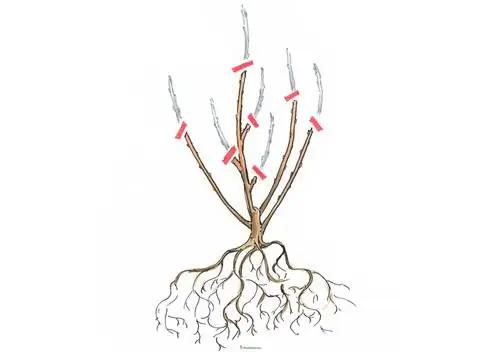
In the spring after autumn planting, cut back all shoots by a third or half. This activates strong branching. Depending on the space capacity, you can grow a blackcurrant with up to 12 vital ground shoots.
Complete maintenance pruning in spring
On blackcurrants, the transition from training to maintenance pruning is smooth. Under ideal conditions, the berry bush will produce its first flowers and fruits from its second year onwards. With this pruning care you support the growth of productive long shoots and preserve a young structure:
- Plucked long shoots cut back to 2 cm short cones
- Saw off a third of the old, dark brown main branches at ground level
- In exchange, leave young, light brown ground shoots uncut
- Remove excess, weak ground shoots
- Cut back the remaining main branches to the 2nd or 3rd long shoot
- Cut off short shoots along scaffolding shoots on astring
A black currant with a few, all-round exposed ground shoots delivers a better yield than a bush with numerous main branches that shade each other. You have made the perfect maintenance cut when the shrub ends up with up to 12 light-flooded scaffolding branches, which only have annual long shoots in the outer area.
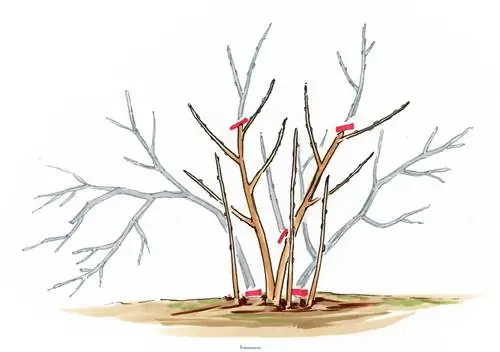
The maintenance cut clears the way for annual long shoots. Cut one main branch back to the second or third side shoot. Remove the three oldest scaffold branches completely in exchange for three promising young ground shoots.
Excursus
Cutting acts as plant protection
Fungal pathogens have blackcurrants in their sights. By cutting at the right time, you can prevent the spread of diseases in the berry bush. The focus is on currant columnar rust and powdery mildew. Brown coating on the undersides of leaves or a mealy coating on the tops of leaves are symptoms of an infection. Cut outall affected canespromptly. Under no circumstances should you dispose of the clippings in the compost; instead, put them in the trash can. Then clean the scissors (€14.00 on Amazon) meticulously with hot water and disinfect the cutting edges with spirit or alcohol.
Rejuvenate aged blackcurrants
If you have lost sight of blackcurrants, the berry bushes will quickly degenerate into an impenetrable thicket with few flowers and fruits. A radical rejuvenation cut can help. This is how it works:
- The best time is at the end of winter until the beginning of March at the latest
- Dark brown scaffold brancheswithout light brown side shoots Thin out at ground level
- Dark brown scaffold brancheswith light brown side shoots divert at the fork
- Leave young shoots on the ground as a starting point for a new structure
Ideally, an old blackcurrant has both young ground shoots and scaffolding branches with light brown side shoots. If both components are missing, a rejuvenation cut has no chance of success. In this case, it is advisable to clear the weakened berry bush.
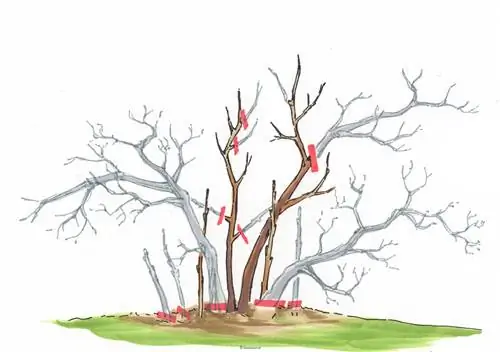
Cut up to three quarters of the exhausted scaffolding shoots with dark brown wood at ground level. Scaffold shoots with promising, light brown side shoots can be shortened using a derivation cut. Raise the best young ground shoots as new scaffolding.
Background
Successful concept of derivation cut
The aging process progresses rapidly in black currants. If the gardener is experienced in the cutting technique of a derivation, a berry bush will remain young, vital and productive for many years. To determine the correct interface, examine the main branch in question for young, light brown side shoots. Select the second or third side shoot that grows outward. Cut off the worn-out scaffolding shoots at the junction of old and young wood. To avoid damaging the fresh fruit wood, place the scissors 1 to 2 millimeters into the dark brown old wood.
Topiary tree trunk
Blackcurrants refined into standard stems are the best sellers in tree nurseries and garden centers. Space-saving growth, uncomplicated pruning care and aromatic berries make the hearts of hobby gardeners beat faster. An annual topiary keeps the standard currant tree in a blooming mood. How to cut correctly:
- Advantageous crown shape: central shoot with up to 6 symmetrically arranged leading shoots
- Best time to cut: after harvest or in February/March
- Cut back worn fruit canes to short cones
- Remove weak, crossing branches that grow inwards or steeply upwards
Pruning is a good opportunity to check the support post. Currant standard stems are at risk of breakage at the grafting point. To ensure that the crown does not bend under the load of the berries, a solid wooden stake ensures stability over the entire growth height. The central shoot of the crown should be tied at least once. The trunk and support should be connected to each other in two places.
Frequently asked questions
Are blackcurrants self-fertile?
The most popular varieties thrive as self-pollinating berry bushes. It is still advisable to plant at least two varieties of blackcurrants to improve crop yield and fruit quality. It is important to note that there is sufficient planting distance of at least 100 centimeters so that the bushes develop unhindered and do not shade each other.
Does a blackcurrant have to be cut as a standard tree? If yes, when and how much?
Black currants have the best fruit wood on their annual long shoots. Therefore, the berry bushes will age within a short time if they are not cut regularly. This also applies to high-yield cultivation as standard stems. Cut out any dead wood to make room for young fruiting wood. The best time for maintenance pruning is in early spring.
Should blackcurrants be cut after autumn planting?
Light pruning on the day of planting is recommended to stimulate the branching of the young shoots. Please limit the cutting to the shoot tips and damaged root strands. Cutting the wood too deeply increases the risk of frost damage. You don’t do the actual planting cut until the beginning of March. Cut back all shoots by a third or half. This allows the blackcurrant to branch beautifully and form numerous fruit canes.
Two long, thin shoots sprout from the trunk of my black currant. How should I handle this?
High stems are a combination of robust base and refined crown. Sometimes the rootstock tends to sprout on its own. These branches strive to overgrow the crown and compete for nutrients, water and light. Therefore, remove the wild shoots as quickly as possible.
The 3 most common cutting mistakes
An incorrect pruning time or improper pruning can significantly affect the enjoyment of blackcurrants. To protect you from devastating results, the following table lists the three most common cutting mistakes and provides tips on how to avoid them:
| Cutting errors | malicious image | Prevention |
|---|---|---|
| cut in autumn | massive frost damage to fruit wood | pruning in spring or after harvest |
| never cut | brush-like growth, low crop yield | cut once a year |
| over-aged ground shoots not thinned out | premature senescence, little young fruit wood | from the 4th year, replace three old ground shoots with three young ones |

Tip
Jostaberries are a successful cross between blackcurrant and gooseberry with extra large berries. Josta bushes are extremely vigorous. To slow down excessive growth, pruning in summer is recommended. The cutting method is no different from black currants. In addition, shorten this year's rods by half at the end of June.


